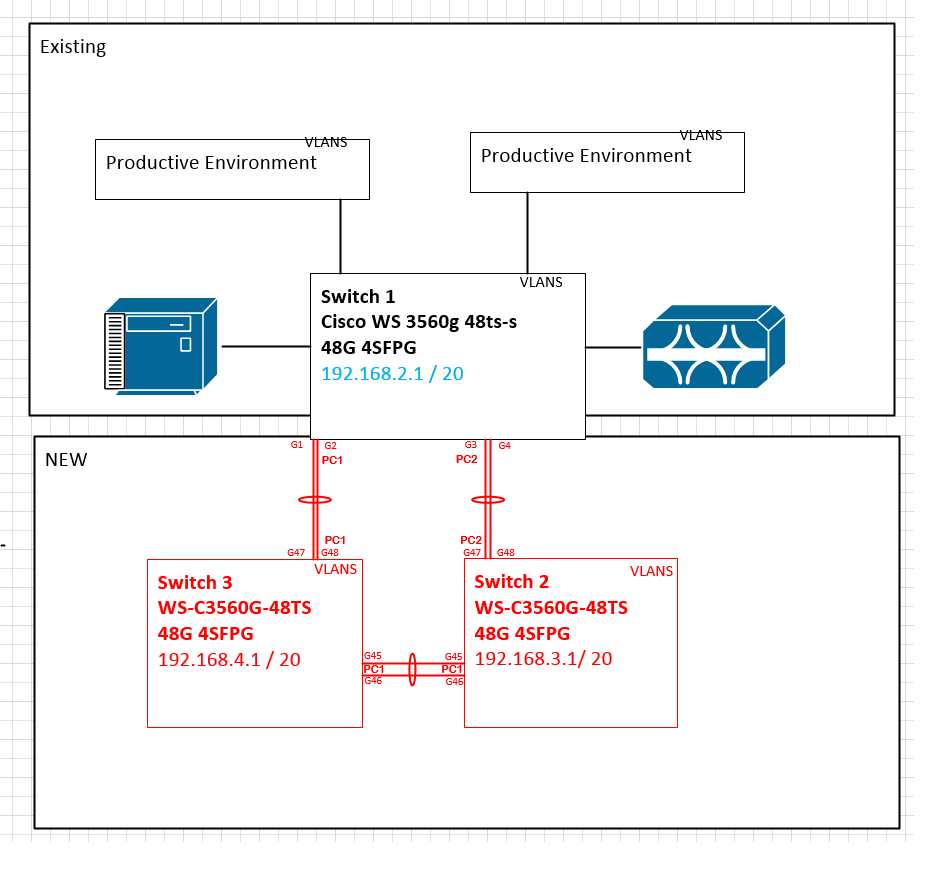- Cisco Community
- Technology and Support
- Networking
- Routing
- Spanning tree with Portchannel (Loop incoming?)
- Subscribe to RSS Feed
- Mark Topic as New
- Mark Topic as Read
- Float this Topic for Current User
- Bookmark
- Subscribe
- Mute
- Printer Friendly Page
- Mark as New
- Bookmark
- Subscribe
- Mute
- Subscribe to RSS Feed
- Permalink
- Report Inappropriate Content
02-19-2015 06:00 AM - edited 03-05-2019 12:50 AM
Dear Cisco Friends
I'm currently configuring 2 Switches to an additional Switch ( all 48 Ports, Catalyst 3560G) and i want to configure them as following (red = new):

PC = Portchannel
As you see, i already configured the ports on every switch and the last step i want to do is to ensure that when i will connect these 2 switches to my root switch, that there will be zero network issues like spanning tree recalculations.
currently the root switch (192.168.2.1) doesn't have any spanning tree configurations so do switches 2 and 3.
I'm afraid to just connect them together to make a huge chaos, so how can i ensure myself that there is no Loop or spanning tree issues without just trying it out?
(also maybe which spanning tree configurations you might find appropriate? simple ones are prefered))
Thanks for your help!
Greetings
Solved! Go to Solution.
- Labels:
-
Other Routing
Accepted Solutions
- Mark as New
- Bookmark
- Subscribe
- Mute
- Subscribe to RSS Feed
- Permalink
- Report Inappropriate Content
02-19-2015 07:10 PM
Hi there. Here are a few things/suggestions that you should do:
1. If switch 1 is to be the root of your STP then you should configure it to be the root for all VLANs
2. Configure "root guard" on all other ports to prevent other switches from becoming a root switch
3. Ensure that all switches are running the same type of STP. For instance, RPVSTP
4. Configure the new switches with high STP priority
5. Ensure that the new switches are running in VTP "transparent" mode
6. You will have spanning-tree blocking but it should be happening on the port-channel that is between your two new switches
I hope this helps!
Thank you for rating helpful posts!
- Mark as New
- Bookmark
- Subscribe
- Mute
- Subscribe to RSS Feed
- Permalink
- Report Inappropriate Content
02-19-2015 07:10 PM
Hi there. Here are a few things/suggestions that you should do:
1. If switch 1 is to be the root of your STP then you should configure it to be the root for all VLANs
2. Configure "root guard" on all other ports to prevent other switches from becoming a root switch
3. Ensure that all switches are running the same type of STP. For instance, RPVSTP
4. Configure the new switches with high STP priority
5. Ensure that the new switches are running in VTP "transparent" mode
6. You will have spanning-tree blocking but it should be happening on the port-channel that is between your two new switches
I hope this helps!
Thank you for rating helpful posts!
Discover and save your favorite ideas. Come back to expert answers, step-by-step guides, recent topics, and more.
New here? Get started with these tips. How to use Community New member guide